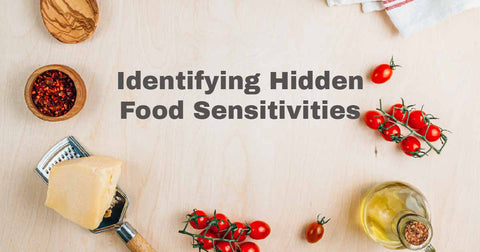In a world where dietary choices significantly impact our well-being, hidden food sensitivities have emerged as a significant concern. Unlike the immediate and often dramatic reactions seen in food allergies, food sensitivities can be elusive, causing delayed and sometimes perplexing symptoms.
Food sensitivities are distinct from food allergies and intolerances. While allergies trigger rapid immune responses, sensitivities induce a subtler, delayed immune reaction. This immune response is often mediated by immunoglobulin G (IgG) antibodies, leading to a cascade of symptoms throughout the body.
Several factors contribute to the development of food sensitivities. Genetics, gut health, and frequent exposure to specific foods can all play a role. Over time, the immune system can become sensitized to certain components of these foods, resulting in a range of symptoms.
Common Symptoms of Hidden Food Sensitivities

While food allergies tend to create swift and noticeable reactions, food sensitivities are adept at disguising themselves, revealing their presence through an array of common yet often baffling symptoms. From disturbances in the digestive realm to intriguing alterations in the skin, respiratory system, joints, muscles, and even the intricate workings of the brain, we explore how these symptoms manifest and offer insights into why they occur.
Digestive Symptoms
Among the most prevalent manifestations of hidden food sensitivities are digestive issues such as persistent bloating, excessive gas, erratic bowel movements (diarrhea or constipation), and abdominal discomfort. These symptoms can often be chronic and may vary in severity.
Skin-Related Symptoms
Food sensitivities can also present themselves on the skin. Eczema, characterized by red, itchy patches, and recurrent rashes are common signs. Acne and unexplained itchiness are also potential indicators of underlying sensitivities.
Respiratory Symptoms
The impact of hidden food sensitivities extends beyond the gut and skin. Respiratory symptoms such as nasal congestion, wheezing, chronic coughing, and symptoms resembling sinusitis can result from an inflammatory response triggered by specific foods.
Joint and Muscle Symptoms
Discomfort in joints, muscle aches, and a general feeling of inflammation might indicate an immune response caused by certain foods. These symptoms can have a direct impact on mobility and overall quality of life.
Neurological Symptoms
The intricate connection between diet and brain health is underscored by neurological symptoms associated with hidden food sensitivities. Headaches, migraines, cognitive fog, and mood disturbances can all be potential outcomes of such sensitivities.
Challenges of Identifying Hidden Food Sensitivities

Unraveling the intricate puzzle of hidden food sensitivities can indeed be a perplexing and often frustrating endeavor. Unlike food allergies that typically exhibit immediate and unmistakable reactions, hidden food sensitivities have a knack for cloaking themselves behind a curtain of delayed symptoms, making them far trickier to identify. This challenge is compounded by the fact that these symptoms can mimic a wide range of other conditions, leading to potential misdiagnosis and prolonged discomfort.
Delayed Onset of Symptoms
One of the most confounding aspects of hidden food sensitivities is the delayed onset of symptoms. Unlike allergies that trigger an almost instantaneous immune response, sensitivities can lay dormant for hours or even days before manifesting as discomfort, inflammation, or other unwanted effects. This time gap between consumption and reaction complicates the process of pinpointing the specific trigger, leaving patients with a sense of uncertainty.
Mimicry of Other Conditions
Adding to the complexity, the symptoms of hidden food sensitivities often mimic those of other health conditions. For instance, the bloating and digestive distress caused by certain sensitivities might mirror irritable bowel syndrome (IBS), while skin-related symptoms like eczema might be mistaken for dermatological issues. This mimicry can lead to misdiagnosis, leading people down a rabbit hole of treatments that fail to address the underlying cause.
The Value of a Comprehensive Food Diary
In the quest to overcome these formidable challenges, a simple yet powerful tool emerges – the food diary. Maintaining a detailed record of your dietary intake along with subsequent symptoms can provide invaluable insights. Every morsel you consume, every beverage you sip becomes a data point that, over time, can help establish patterns that might otherwise go unnoticed.
Your food diary becomes a bridge between cause and effect, a way to connect the dots between what you eat and how your body responds. It enables you to identify trends that might not be apparent in the heat of the moment, helping you discern if certain foods consistently precede specific symptoms. Armed with this information, you're better equipped to make informed decisions about what to include or exclude from your diet.
Testing Options for Food Sensitivities
As the symptoms of these sensitivities often manifest in subtle and delayed ways, identifying the specific trigger can be tough. Fortunately, science has devised techniques to help unravel the mystery. From the practicality of elimination diets to the insights offered by blood tests, skin prick tests, functional medicine approaches, and breath tests, we embark on a journey through the landscape of diagnostic tools.
Several methods are available to help uncover hidden food sensitivities such as:
Elimination Diets
An elimination diet isn't just a diet—it's a personalized investigation into the intricacies of your body's responses to food. By systematically excluding suspected trigger foods from your meals, you create a blank canvas for observing your body's reactions. After a period of elimination, the reintroduction phase commences, where foods are reintroduced one at a time.
As you reintroduce each food group, you meticulously observe any changes in your physical and emotional well-being. This process, though demanding, can yield remarkable insights into the foods that might be behind your hidden sensitivities. Patience and commitment are paramount, but the reward is a clearer understanding of your unique dietary landscape.
Blood Tests

Blood tests, specifically those examining IgG antibodies, provide a window into your body's immune reactions to specific foods. These tests analyze a blood sample to detect antibodies that your immune system produces in response to particular foods.
While the reliability of IgG antibody testing remains a topic of debate, when combined with a comprehensive clinical history, these tests can offer valuable insights. They can indicate which foods might be triggering immune responses and guide your dietary adjustments. Consulting a healthcare professional well-versed in interpreting these results can provide a more accurate assessment of your sensitivities.
Skin Prick Tests
Skin prick tests are renowned for diagnosing allergies, but their potential for uncovering immediate sensitivities mediated by IgE antibodies extends further. In this test, a small amount of the suspected allergen is applied to your skin, and the ensuing reaction is observed.
However, the drawback lies in their limited ability to detect delayed sensitivities, which are often tied to IgG antibodies. If immediate reactions are suspected, skin prick tests can provide quick insights. Yet, for hidden sensitivities with a delayed onset, other approaches may be more informative.
Functional Medicine Approaches
Functional medicine brings the spotlight to the intricate gut-immune interaction, crucial in understanding hidden food sensitivities. Comprehensive stool analysis delves into your gut health, examining the composition of your gut microbiota and any imbalances that could contribute to sensitivities.
IgA testing focuses on your body's production of immunoglobulin A, which plays a vital role in gut immunity. These tests provide a holistic view of the interplay between your gut health and immune responses, shedding light on the mechanisms behind your sensitivities.
Breath Tests
Breath tests offer a window into the digestive world and how it influences food sensitivities. The hydrogen breath test, for instance, uncovers carbohydrate malabsorption by detecting hydrogen gas produced by bacteria in your gut. This can highlight foods that your body struggles to process effectively.
The methane breath test targets small intestinal bacterial overgrowth (SIBO), a condition that can exacerbate sensitivities. By understanding the intricate digestive dynamics, these tests provide insights into conditions contributing to your sensitivities.
Each testing option has its strengths and limitations, making a multifaceted approach often the most effective. Consulting healthcare professionals experienced in food sensitivities can guide you through the selection and interpretation of these tests, ensuring a more accurate diagnosis and a tailored management plan.
Seeking Professional Guidance

While self-diagnosis and experimentation are tempting, seeking guidance from healthcare professionals is essential when dealing with hidden food sensitivities. Registered dietitians and allergists possess the expertise needed to navigate the complexities of dietary sensitivities. Their knowledge can help ensure accurate diagnosis and guide you toward effective management strategies tailored to your individual needs.
The guidance of a healthcare provider is invaluable when it comes to identifying and managing hidden food sensitivities. Professionals can conduct a thorough assessment of your medical history, symptoms, and potential risk factors, allowing for a more accurate diagnosis and personalized treatment plan.
Registered dietitians play a pivotal role in helping you decipher your dietary triggers. They can create personalized elimination diets, offer nutritional guidance, and monitor your progress. Allergists, on the other hand, specialize in diagnosing and treating allergies and sensitivities, ensuring you receive accurate and comprehensive care.
Lifestyle Strategies for Managing Food Sensitivities
Once you've identified your hidden food sensitivities, managing them becomes a critical aspect of maintaining your well-being. The following strategies can help you navigate your dietary choices and reduce the impact of sensitivities on your daily life:
Personalized Diet Planning
Collaborating with a dietitian to develop a personalized eating plan is key. By crafting a diet that excludes trigger foods while ensuring adequate nutrition, you can maintain a balanced and enjoyable diet.
Food Rotation and Diversification
Rotate your food choices to minimize the risk of developing new sensitivities. By diversifying your diet, you reduce the likelihood of overexposing your immune system to specific foods, which can contribute to sensitivities.
Gut Health Optimization
Prioritize gut health through dietary and lifestyle choices. Incorporating probiotics, prebiotics, and foods rich in fiber can promote a healthy gut microbiome, which can alleviate the impact of food sensitivities.
Stress Management
Chronic stress can exacerbate food sensitivities and their symptoms. Engaging in stress-reduction techniques such as meditation, yoga, deep breathing exercises, and mindfulness can help modulate your body's response to sensitivities.
The Takeaway
In conclusion, hidden food sensitivities can have a profound impact on your overall well-being, affecting various aspects of your health from digestion to skin, respiratory, joint, and even neurological function. Recognizing the common symptoms and employing appropriate testing methods are essential steps toward identifying these sensitivities.
While navigating the complexities of hidden food sensitivities may seem daunting, remember that professional guidance and strategic lifestyle adjustments can significantly improve your quality of life. By working closely with healthcare providers and implementing personalized strategies, you can take control of your diet and optimize your health.
Prioritizing the identification and management of hidden food sensitivities not only promotes physical well-being but also contributes to enhanced mental and emotional health. With a well-informed approach, you can achieve a harmonious balance between your dietary choices and your overall vitality.
Watch AFIL test kits testimonial videos click here
References:
- Sampson, Hugh A. "Food allergy. Part 2: diagnosis and management." Journal of Allergy and Clinical Immunology 103.6 (1999): 981-989.
- Sicherer, Scott H., and Hugh A. Sampson. "Food hypersensitivity and atopic dermatitis: pathophysiology, epidemiology, diagnosis, and management." Journal of Allergy and Clinical Immunology 104.3 (1999): S114-S122.
- Macchia, Donatella, et al. "Guidelines for the use and interpretation of diagnostic methods in adult food allergy." Clinical and Molecular Allergy 13.1 (2015): 1-12.
- Sicherer, Scott H., and Hugh A. Sampson. "Food allergy: a review and update on epidemiology, pathogenesis, diagnosis, prevention, and management." Journal of Allergy and Clinical Immunology 141.1 (2018): 41-58.


.png?v=1737390083)
.png?v=1737187409)


